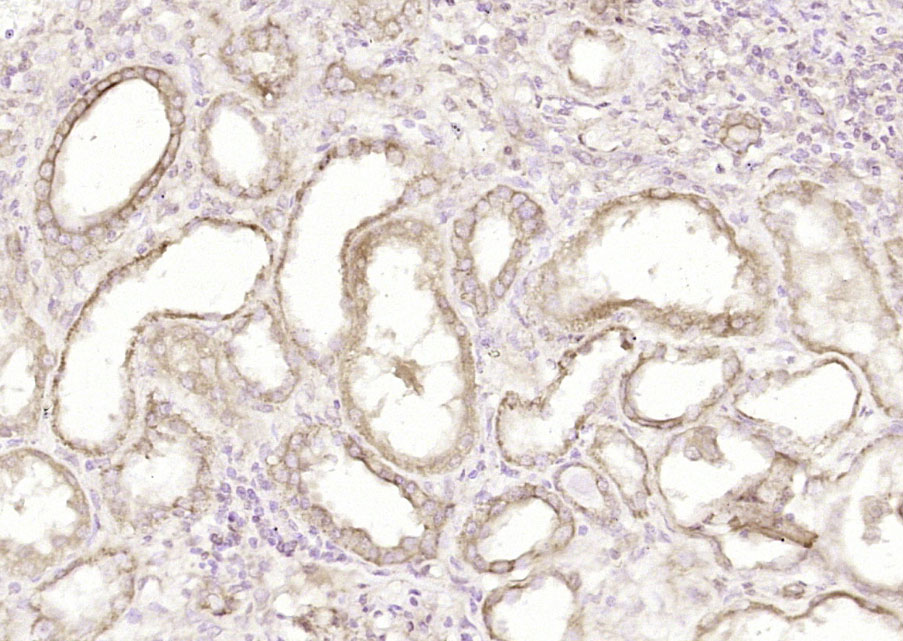
Rabbit Anti-APOL1 antibody
APO L; Apo-L; APOL; APOL I; ApoL-I; APOL1; Apolipoprotein L1; APOL1_HUMAN; APOLI; APOL1; APOL 1; APOL-1; Apolipoprotein L; Apolipoprotein L I; Apolipoprotein L-I; Apolipoprotein L1; Apolipoprotein L-1; FSGS4.
View History [Clear]
Details
Product Name APOL1 Chinese Name 载LipoproteinL1抗体 Alias APO L; Apo-L; APOL; APOL I; ApoL-I; APOL1; Apolipoprotein L1; APOL1_HUMAN; APOLI; APOL1; APOL 1; APOL-1; Apolipoprotein L; Apolipoprotein L I; Apolipoprotein L-I; Apolipoprotein L1; Apolipoprotein L-1; FSGS4. literatures Research Area Tumour Cell biology The new supersedes the old Immunogen Species Rabbit Clonality Polyclonal React Species Human, Applications WB=1:500-2000 ELISA=1:5000-10000 IHC-P=1:100-500 IHC-F=1:100-500 ICC=1:100-500 IF=1:100-500 (Paraffin sections need antigen repair)
not yet tested in other applications.
optimal dilutions/concentrations should be determined by the end user.Theoretical molecular weight 41kDa Cellular localization Secretory protein Form Liquid Concentration 1mg/ml immunogen KLH conjugated synthetic peptide derived from human APOL1/Apolipoprotein L: 201-300/398 Lsotype IgG Purification affinity purified by Protein A Buffer Solution 0.01M TBS(pH7.4) with 1% BSA, 0.03% Proclin300 and 50% Glycerol. Storage Shipped at 4℃. Store at -20 °C for one year. Avoid repeated freeze/thaw cycles. Attention This product as supplied is intended for research use only, not for use in human, therapeutic or diagnostic applications. PubMed PubMed Product Detail Apolipoproteins are protein components of plasma lipoproteins (1). The apolipoprotein L gene family encodes six highly homologous proteins designated apoL-I to -VI, which are associated with large high density type lipoproteins (HDL) (2,3). The human apoL family maps to chromosome 22q12.1-13.1 within a 127,000-bp region (4). ApoL has been characterized as a pancreas specific, 383-amino acid protein that contains a 12-amino acid secretory signal peptide (4). The apoL genes have TATA-less promoters and contain putative sterol regulatory elements, suggesting that transcription of these genes may be coordinated with that of the low density lipoprotein receptor and genes in pathways involving the synthesis of triglycerides and cholesterol (3). ApoL homologs can undergo 10 fold changes in expression during atherosclerotic changes in vascular endothelial cells, which includes the inflammatory reaction of atherosclerotic lesions (5).
Function:
May play a role in lipid exchange and transport throughout the body. May participate in reverse cholesterol transport from peripheral cells to the liver.
Subunit:
In plasma, interacts with APOA1 and mainly associated with large high density lipoprotein particles.
Subcellular Location:
Secreted.
Tissue Specificity:
Plasma. Found on APOA-I-containing high density lipoprotein (HDL3). Expressed in pancreas, lung, prostate, liver, placenta and spleen.
Post-translational modifications:
Phosphorylation sites are present in the extracelllular medium.
DISEASE:
Defects in APOL1 are the cause of focal segmental glomerulosclerosis type 4 (FSGS4) [MIM:612551]. It is a renal pathology defined by the presence of segmental sclerosis in glomeruli and resulting in proteinuria, reduced glomerular filtration rate and edema. Renal insufficiency often progresses to end-stage renal disease, a highly morbid state requiring either dialysis therapy or kidney transplantation.
Similarity:
Belongs to the apolipoprotein L family.
SWISS:
O14791
Gene ID:
8542
Database links:Entrez Gene: 8542 Human
Omim: 603743 Human
SwissProt: O14791 Human
Unigene: 114309 Human
Product Picture
Bought notes(bought amounts latest0)
No one bought this product
User Comment(Total0User Comment Num)
- No comment



 +86 571 56623320
+86 571 56623320
 +86 18668110335
+86 18668110335

